Peppercorn Pandemonium

Overview of Peppercorn Pandemonium
Peppercorn Pandemonium is India's most popular mobile game centered around the exciting world of spices, specifically focusing on the adventurous journey of pepper harvesting, trading, and challenges.
Developed by a Bangalore-based game studio in 2021, the game has taken the Indian gaming market by storm with its unique blend of cultural references, addictive gameplay, and vibrant visuals that resonate deeply with Indian players.
The game's concept draws inspiration from India's rich history as a major pepper producer and trader, dating back to ancient times when Indian black pepper was one of the most valuable commodities in the world.
Peppercorn Pandemonium cleverly weaves this historical significance into a modern gaming experience that appeals to both casual players and serious gamers alike.
Available in 11 Indian languages including Hindi, Bengali, Tamil, Telugu, Marathi, Gujarati, Kannada, Malayalam, Punjabi, Odia, and Assamese, Peppercorn Pandemonium has successfully broken language barriers.
It has become a unifying gaming phenomenon across the diverse Indian subcontinent, bringing together players from different regions and backgrounds through their shared love for spices and gaming.
📊 Key Statistics of Peppercorn Pandemonium
What truly sets Peppercorn Pandemonium apart from other mobile games in India is its deep integration of local traditions, festivals, and regional preferences.
The game regularly updates its content to coincide with major Indian festivals like Diwali, Holi, Pongal, and Eid, offering special in-game events and rewards that keep the player base engaged throughout the year.
The game's developers have worked closely with cultural experts from different regions of India to ensure that the content remains authentic and respectful of local traditions while still providing an entertaining experience.
This attention to cultural detail has been widely appreciated by players across the country, who often comment on how the game feels "made for us, by us."

Gameplay Mechanics of Peppercorn Pandemonium
The core gameplay of Peppercorn Pandemonium revolves around managing a pepper farm, processing the harvested peppers, trading them in various markets across India, and participating in spicy challenges.
Each of these elements contributes to the overall progression in the game, allowing players to expand their farming operations, unlock new regions, and gain recognition as master pepper traders.
🌱 Farming and Harvesting
Players start with a small pepper farm in one of India's major pepper-producing regions—either Kerala, Karnataka, or Assam. Each region offers different varieties of peppers with unique characteristics.
These characteristics affect gameplay in various ways, such as growth time, resistance to pests, market value, and suitability for different processed products.
Farming involves planting pepper vines, watering them, protecting them from pests using organic pesticides (a nod to India's growing organic farming movement), and eventually harvesting the peppercorns.
The timing of harvesting is crucial in Peppercorn Pandemonium. Harvesting too early results in lower quality peppers that fetch lower prices, while waiting too long may result in over-ripening.
As players progress, they can unlock advanced farming techniques, better irrigation systems, and pest control methods that are inspired by traditional Indian agricultural practices combined with modern innovations.
🏭 Processing and Production
After harvesting, players process their peppercorns using traditional methods that vary by region. In Kerala, for example, players can use the traditional sun-drying method.
In Karnataka, they might employ mechanical drying techniques for faster processing, while in Assam, certain varieties undergo a unique fermentation process that gives them a distinctive flavor profile.
Processing can transform basic peppercorns into value-added products like pepper powder, pepper oil, and even special spice blends that include other Indian spices like cardamom, cloves, and cinnamon.
These processed products command higher prices in the market and are often in demand for specific regional recipes and events within the game.
Players can upgrade their processing facilities as they progress, allowing them to produce higher quality products more efficiently and even develop unique proprietary blends that become their signature in the game's markets.
🏪 Trading and Markets
One of the most engaging aspects of Peppercorn Pandemonium is its dynamic market system. Players can sell their pepper products in various markets across India, each with its own demand patterns.
Major markets include the historical spice markets of Kochi, the bustling bazaars of Delhi, the seafood markets of Mumbai where pepper is in high demand, and the export hubs of Chennai and Kolkata.
Each market has its own unique characteristics—for example, the Kochi market values traditional processing methods, while the Mumbai market pays a premium for organic certifications.
Market prices change based on in-game events, seasonal variations, and even real-world weather patterns that affect actual pepper production in India. This dynamic system keeps the trading aspect fresh.
Players can develop relationships with regular buyers, negotiate prices (using techniques familiar to anyone who has visited an Indian market), and even engage in speculative trading by anticipating market trends.

🌶️ Spicy Challenges
No aspect of Peppercorn Pandemonium has generated as much discussion and engagement as its "Spicy Challenges"—mini-games that test players' skills and tolerance for virtual heat.
These challenges include pepper-sorting puzzles, timed grinding competitions, and even a popular "Pepper Eating Contest" where players simulate consuming increasingly spicy peppers.
The "Pepper Eating Contest" features humorous in-game reactions that have become viral memes on Indian social media, with characters sweating profusely, reaching for water, and making funny faces.
Other challenges include identifying pepper varieties by sight and smell (represented through visual and audio cues), creating the perfect spice blend for a celebrity chef character, and navigating a virtual spice bazaar within a time limit.
Successfully completing these challenges earns players special rewards, including rare pepper varieties, advanced farming equipment, and exclusive market access that can significantly boost their in-game profits.
👪 Community and Social Features
Peppercorn Pandemonium encourages social interaction through its community features. Players can form "Spice Guilds" with friends and other players, collaborate on large-scale farming projects.
They can also compete against other guilds in weekly "Spice Wars" tournaments where the goal is to produce the highest quality pepper products or achieve the highest trading profits within a specified time period.
The game also includes a gifting system where players can send each other rare pepper seeds or helpful farming items, fostering a sense of community and cooperation that mirrors the social fabric of rural Indian life.
In rural India, neighbors often help each other during harvest seasons, a tradition that is reflected in the game's cooperative gameplay elements. Guild members can assist each other with pest control, irrigation, and harvesting during busy periods.
Regular community events, such as nationwide pepper harvesting competitions, bring players together from across India, creating a sense of national unity through shared gaming experiences.
Download Statistics and Regional Popularity
Since its launch in early 2021, Peppercorn Pandemonium has achieved remarkable download numbers across India, cementing its position as one of the country's most popular mobile games.
As of the latest figures, the game has been downloaded over 85 million times in India alone, with an average of 500,000 new downloads every week. This growth shows no signs of slowing down.
The game's popularity can be attributed to several factors, including its cultural relevance, accessible gameplay that appeals to all age groups, and optimization for lower-end Android devices that are prevalent in many parts of India.
Unlike many mobile games that require high-end smartphones, Peppercorn Pandemonium can run smoothly on devices with limited processing power and storage, making it accessible to a wider audience.
📱 Regional Download Distribution
The game's popularity is fairly evenly distributed across India's major regions, with slight concentration in South India where pepper cultivation is more prominent in real life.
Kerala, Karnataka, and Tamil Nadu consistently rank among the top states for Peppercorn Pandemonium downloads and active players, perhaps due to the cultural familiarity with pepper farming in these regions.
Interestingly, the game has found particular success in rural areas, with approximately 45% of its player base coming from non-urban locations. This is partly due to the game's relatable agricultural themes.
The developers' decision to include regional languages and farming practices that resonate with rural players has also contributed to this strong rural adoption rate.
📅 Download Trends Over Time
Peppercorn Pandemonium has experienced several significant download spikes coinciding with major updates and promotional events:
The game's first major surge came during the 2021 Diwali season when a special "Diwali Spice Festival" event was launched, featuring exclusive in-game items and a limited-time marketplace modeled after traditional Diwali markets.
This event resulted in a 300% increase in weekly downloads, as players were drawn to the festive content and special rewards that could only be obtained during the celebration period.
Another notable spike occurred in March 2022 when the game introduced its "Holi Pepper Challenge," allowing players to throw colored pepper packets at each other in a virtual celebration of the festival.
This culturally relevant update resonated strongly with players, leading to over 5 million new downloads in a single week and generating significant buzz on social media platforms.
Similar spikes have been observed during other major Indian festivals, demonstrating the effectiveness of the game's strategy to align content updates with cultural events that are important to Indian players.

The game's availability on both Google Play Store and Apple App Store has contributed to its widespread adoption, though Android devices account for approximately 85% of Peppercorn Pandemonium downloads.
This reflects the overall mobile market distribution in India, where Android devices dominate due to their lower price points and wider availability across urban and rural areas.
Downloads are not limited to India, however. The game has gained a following among the Indian diaspora in countries like the United States, United Kingdom, Canada, and Singapore.
For these players, Peppercorn Pandemonium serves as a nostalgic connection to Indian culture and cuisine, allowing them to engage with elements of their heritage through gameplay.
Player Reviews and Reception
Peppercorn Pandemonium has received overwhelmingly positive reviews from Indian players, earning an average rating of 4.7 out of 5 across app stores. This high rating is particularly impressive.
It's notable given the game's large number of reviews—over 1.25 million at last count—indicating that the positive reception is widespread and not limited to a small group of players.
Players frequently praise the game's authentic representation of Indian culture, its addictive yet relaxing gameplay, and the developers' responsiveness to player feedback.
Many reviews mention how the game has introduced them to aspects of Indian agricultural practices and regional spice traditions they were previously unfamiliar with, serving an educational purpose alongside entertainment.
👍 Positive Reviews
"Peppercorn Pandemonium reminds me of my grandfather's farm in Junagadh! The attention to detail in the farming mechanics is amazing. I love how they've included different farming techniques from across India. The Diwali events are always so much fun and bring back childhood memories."
"I've been playing Peppercorn Pandemonium for over a year now, and I'm still not bored! The market fluctuations keep the trading interesting, and I love competing in the weekly challenges with my friends. The only reason I'm not giving 5 stars is that some of the higher levels can be a bit pay-to-win."
"As someone who works in the spice export business, I'm impressed by how accurate Peppercorn Pandemonium is! The game actually teaches you about different pepper varieties and market forces. My children love it too—they've learned more about Indian agriculture from this game than from their school textbooks!"
"The Urdu version of Peppercorn Pandemonium is beautifully done—they've used proper terminology that feels natural, not like a machine translation. I play with my whole family during Ramadan, and we love the special Eid events. It's wonderful to see our traditions represented in a mobile game."
👎 Constructive Criticism
While most reviews are positive, some players have pointed out areas for improvement. Common criticisms include occasional server lag during peak hours, particularly during major festivals when player activity spikes.
The developers have addressed this issue by investing in additional server capacity and implementing better load balancing during high-traffic periods, resulting in noticeable improvements.
Some players have also noted that while the game is free to play, progress can become slow at higher levels without making in-app purchases. The developers have responded to this feedback by introducing more opportunities.
They've added more ways to earn premium items through gameplay rather than purchases, including daily login rewards, achievement bonuses, and increased rewards for participating in community events.
"I enjoy Peppercorn Pandemonium but find that after level 30, it's hard to progress without spending money. The Bengali translation is good, but there are some regional terms that aren't quite right. The game has great potential though, and I love seeing familiar marketplaces from Kolkata in the game."
Overall, the reception of Peppercorn Pandemonium has been highly positive, with many players appreciating the game's unique concept and cultural relevance.
The developers have established a reputation for listening to player feedback and regularly implementing improvements based on community suggestions, which has helped maintain player satisfaction and loyalty over time.

Localization and Regional Variations
One of Peppercorn Pandemonium's greatest strengths is its extensive localization efforts, which have helped it resonate with players across India's diverse linguistic and cultural landscape.
The game is available in 11 Indian languages, with region-specific content that reflects local traditions and preferences, making players from different parts of India feel seen and represented.
🗣️ Language Localization
The development team worked with native speakers and cultural experts to ensure accurate translations that capture regional nuances. For example, the Hindi version uses appropriate terminology familiar to players across the Hindi belt.
The Tamil version incorporates colloquial expressions that resonate with Tamil speakers, while the Bengali version includes dialectical variations that are familiar to players from different parts of West Bengal and Bangladesh.
Interface elements, tutorials, and in-game dialogue all adapt to the player's chosen language, creating a seamless experience regardless of linguistic background. This commitment to language accessibility has been a key factor.
It has played a significant role in the game's widespread adoption across India, allowing players who may not be fluent in English to fully enjoy and understand the game's content and mechanics.
🌍 Regional Content Differences
Beyond language, Peppercorn Pandemonium features region-specific content that makes the game feel personalized to players from different parts of India:
In South India, players encounter markets styled after Chennai's Koyambedu Market and Bangalore's KR Market, with local vendors wearing traditional attire and selling region-specific pepper varieties like Malabar pepper and Tellicherry pepper.
North Indian players see markets inspired by Delhi's Khari Baoli (Asia's largest spice market) and Lucknow's Aminabad, with vendors in traditional kurta-pajamas and special events tied to North Indian festivals like Lohri and Uttarayan.
East Indian versions feature markets modeled after Kolkata's Burrabazar and Guwahati's Fancy Bazaar, with regional specialties like Assam's king chili peppers making special appearances in gameplay.
West Indian players enjoy markets inspired by Mumbai's Crawford Market and Ahmedabad's Manek Chowk, with special events during festivals like Navratri and Ganesh Chaturthi that feature region-specific celebrations.
These regional variations ensure that players from all parts of India can see elements of their local culture reflected in the game, creating a sense of ownership and connection that enhances the overall gaming experience.

🍛 Culinary Influences
The game's processed pepper products also reflect regional culinary traditions. For example, players in Punjab can create special pepper blends used in Punjabi curries, while those in Kerala can produce pepper-infused coconut oil that's a staple in Kerala cuisine.
In Bengal, players can create unique mustard-pepper mixtures used in traditional Bengali fish preparations, while in Maharashtra, they can produce special Kolhapuri pepper blends known for their intense heat.
These regional variations not only enhance gameplay but also serve an educational purpose, introducing players to culinary traditions from other parts of India and fostering a greater appreciation for the country's diverse food culture.
Many players report that Peppercorn Pandemonium has inspired them to try new recipes using different pepper varieties in real life, creating a meaningful connection between the virtual game world and real-world experiences.
The localization efforts in Peppercorn Pandemonium have set a new standard for mobile games in India, demonstrating how cultural sensitivity and regional customization can lead to widespread adoption and player loyalty.
Localized Events and Celebrations
A major factor in Peppercorn Pandemonium's ongoing popularity is its calendar of localized events that coincide with Indian festivals and cultural celebrations.
These events not only keep the game fresh but also strengthen its connection to Indian culture, giving players additional reasons to engage with the game throughout the year.
🎉 Diwali Special Event
The annual Diwali event is the most anticipated in Peppercorn Pandemonium. During this time, the game world is decorated with diyas (oil lamps), rangoli patterns, and festive lights, creating a truly immersive Diwali atmosphere.
Players can participate in special "Lakshmi Puja" ceremonies in their virtual farms to receive blessings that boost crop yields and improve the quality of their pepper harvests.
A popular feature of the Diwali event is the "Firecracker Pepper Challenge," where players match pepper varieties to create colorful virtual firecrackers. The better the match, the more spectacular the virtual fireworks display.
The event also includes exclusive Diwali recipes that use peppers, allowing players to create virtual sweets and snacks to share with in-game friends and receive special rewards in return.
Diwali events typically run for two weeks leading up to the festival, with new challenges and rewards unlocked each day to keep players engaged and coming back for more.
🎨 Holi Celebration
The Holi event transforms Peppercorn Pandemonium into a vibrant celebration of colors. Players can engage in "Color Pepper Fights," where they throw colored pepper packets at each other and at in-game characters.
These virtual color fights not only add a fun, festive element to the game but also allow players to collect special colored peppers that can be used to create limited-edition pepper products with high market value.
Special Holi bonfires (Holika Dahan) can be lit to purify virtual farms and increase the quality of upcoming pepper harvests. Players can gather around these bonfires with their guild members to receive special bonuses and participate in group challenges.
The event also features a "Gujiya Market" where players can trade special Holi sweets made with pepper, and exclusive rainbow-colored pepper varieties that only appear during the Holi season, making them highly sought after by collectors.
🌾 Harvest Festivals
Peppercorn Pandemonium celebrates India's various harvest festivals with region-specific events. During Pongal in Tamil Nadu, players can create special pongal dishes using their virtual peppers.
They can also participate in bull-taming mini-games inspired by Jallikattu, where successfully guiding bulls through obstacle courses earns players rare seeds and farming equipment.
In Punjab, the game celebrates Baisakhi with virtual harvest dances and special market events where players can sell their peppers at premium prices. The Baisakhi event often features virtual fairs with mini-games and challenges.
Similarly, Onam in Kerala features boat races with pepper-themed boats and elaborate Onam sadya (feasts) that incorporate various pepper products. Players can compete to create the most authentic and delicious virtual sadya.
These harvest festival events not only add variety to the gameplay but also educate players about different regional celebrations, promoting cross-cultural understanding among India's diverse player base.

🌙 Religious Festivals
The game also acknowledges major religious festivals across India. During Eid, players can participate in virtual charity events where donating pepper products earns special rewards.
These donations are converted into virtual meals for in-game characters, promoting the spirit of giving that is central to Eid celebrations. The event often includes virtual feasts with traditional Eid dishes that incorporate peppers.
Christmas features a "Spice Market Bazaar" inspired by the historic Christmas markets of Goa, where players can trade special holiday spice blends and participate in gift-giving activities with other players.
Durga Puja in West Bengal is celebrated with virtual pandals (temporary structures) decorated with pepper vines, and players can participate in special rituals to receive blessings for their farms.
These events are carefully designed to respect religious sensitivities while celebrating the cultural aspects that bring communities together. The developers consult with religious leaders and cultural experts to ensure accurate and respectful portrayal.
Each event in Peppercorn Pandemonium offers unique rewards, limited-time items, and special gameplay mechanics that encourage players to return regularly. This event calendar has proven highly effective in maintaining high player engagement.
Indian Player Strategies and Tips
Indian players have developed unique strategies for Peppercorn Pandemonium that leverage local knowledge and cultural understanding. These tips, shared through community forums and social media groups, can help new players.
They can help new players progress more quickly and enjoy the game to its fullest, while also showcasing the innovative ways Indian players have engaged with and mastered the game's mechanics.
🌱 Farming Strategies
Seasoned players recommend aligning virtual farming with real-world Indian agricultural cycles for optimal results. For example, planting pepper vines just before the monsoon season (June-July in most parts of India) in the game yields better results.
This mirrors real pepper farming practices, where monsoon rains provide ideal growing conditions. Similarly, adjusting watering schedules based on real local weather patterns has been found to improve virtual crop yields.
Players from Kerala suggest focusing on high-value Malabar pepper varieties during the rainy season, while those from Karnataka swear by the heat-resistant Bangalore variety during summer months.
Rotating crops with virtual spices like cardamom and cloves (which are often grown alongside peppers in real Indian farms) can help prevent soil depletion in the game, leading to more consistent harvests.
Many experienced players also recommend following the agricultural advice of in-game non-player characters who are modeled after real Indian farmers, as their tips often contain hidden insights that can significantly boost productivity.
💰 Trading and Market Tips
Indian players have identified patterns in Peppercorn Pandemonium's market system that mirror real-world spice trading in India. For example, prices for pepper products tend to spike before major festivals when demand for spices increases in real life.
Experienced traders recommend building up stockpiles of processed pepper products in the weeks leading up to Diwali, Holi, and Eid, then selling during the festival events for maximum profit. This strategy mirrors real-world spice trading practices.
Players also suggest specializing in region-specific products when trading in certain markets—for example, selling pepper-infused ghee in North Indian markets and pepper coconut oil in South Indian markets, as these products align with local culinary preferences.
Negotiation is an important skill in Indian markets, and this translates to the game as well. Players have discovered that using specific negotiation dialogues that mimic real Indian market haggling can result in better prices.
"In Peppercorn Pandemonium, just like in real life, the best pepper prices in Kerala markets come early in the morning. Log in at 6-7 AM IST to get premium rates for your harvest. Also, never sell directly at the market—always negotiate with the merchants using the 'bargain' option, just like we do in real spice markets!"
🌶️ Mastering Spicy Challenges
Indian players have developed specific techniques for excelling at Peppercorn Pandemonium's Spicy Challenges. For the Pepper Eating Contest, players from Andhra Pradesh and Telangana recommend using a "cooling strategy."
This involves alternating between spicy peppers and virtual cooling foods like yogurt and buttermilk, a technique used in real-life spicy food challenges across India's spicy food regions.
The sorting challenges, which require quick identification of different pepper varieties, are easier for players who are familiar with India's diverse pepper types in real life. Many players recommend studying images of real Indian peppers.
They suggest studying images of real Indian peppers like Kashmiri chili, Guntur chili, and Bird's eye chili to improve their in-game sorting speed. This real-world knowledge directly translates to better performance in these challenges.
For the grinding challenges, players from spice-producing regions often report better performance, as they are familiar with the texture and appearance of properly ground spices from helping in family kitchens.
🤝 Guild and Community Strategies
Successful Spice Guilds in Peppercorn Pandemonium often mirror real Indian community structures, with players from different regions bringing their unique expertise. For example, guilds that include members from farming regions can excel at cultivation.
Those with members from trading hubs like Mumbai and Delhi often dominate market challenges, while players from culinary-rich regions like Punjab and Bengal may have an edge in processing challenges.
Indian players emphasize the importance of regular guild meetings (often scheduled around Indian mealtimes when players are most likely to be available) and distributing tasks based on regional strengths.
Many guilds also follow traditional Indian decision-making practices, seeking consensus before making major guild decisions, which helps maintain harmony and cooperation within the group.
Guilds that organize virtual celebrations for Indian festivals together often report higher member satisfaction and retention, as these activities strengthen social bonds among players.

⏰ Time Management Tips
Indian players have adapted their gameplay to fit around typical daily schedules. Many recommend checking the game briefly during morning tea (chai) breaks to water crops, then spending more time in the evening after work.
This schedule aligns with the natural rhythms of Indian daily life, making it easier to maintain consistent gameplay without disrupting work or family responsibilities.
During festival seasons, players often coordinate with family members to share gameplay duties, turning Peppercorn Pandemonium into a family activity that everyone can participate in, even with busy festival preparations.
Players also suggest aligning gameplay with India's power supply patterns, scheduling resource-intensive activities like processing peppers during times when electricity is more reliable in their area.
This practical strategy ensures they don't lose progress due to unexpected power cuts, a common concern in many parts of India. Some players even use power outage schedules published by local electricity boards to plan their gameplay sessions.
Community and Player Discussions
The Peppercorn Pandemonium community in India has grown into a vibrant ecosystem of players who share tips, celebrate achievements, and even organize real-world meetups. This strong community aspect has been crucial.
It has been crucial to the game's sustained success, creating a sense of belonging and shared experience that extends beyond the virtual game world.
📱 Social Media Groups and Forums
There are thousands of Peppercorn Pandemonium groups on platforms like WhatsApp, Facebook, and Telegram, with many organized by region or language. These groups allow players to share localized strategies.
They coordinate guild activities, and discuss upcoming events in a language and cultural context that feels familiar and comfortable. Regional language groups have been particularly successful in fostering deep community engagement.
Regional forums, particularly in languages like Hindi, Tamil, and Bengali, have become hubs for detailed strategy discussions and troubleshooting. Players often post screenshots of their virtual farms for feedback.
More experienced players offer advice on improving crop yields and profits, creating a mentorship dynamic that helps new players get up to speed quickly. These online communities have become valuable resources for both new and experienced players.
Many of these groups have developed their own internal cultures and traditions, from celebrating members' in-game achievements to organizing virtual festivals and competitions that strengthen community bonds.
🎮 Local Tournaments and Events
One of the most unique aspects of the Peppercorn Pandemonium community in India is the organization of real-world tournaments and meetups. These events range from small gatherings in local cafes to large-scale competitions.
In cities like Bangalore, Chennai, and Mumbai, monthly "Pepper Pandemonium Meets" bring players together to compete in live gameplay challenges, share strategies, and even trade virtual items.
These events often feature real pepper-themed snacks and refreshments, blurring the line between the virtual game and real-world Indian culture. Some events even include cooking demonstrations using different pepper varieties.
During major Indian festivals, some communities organize charity tournaments where in-game achievements are converted into real-world donations to local causes. For example, during the 2022 Diwali season, a Mumbai-based Peppercorn Pandemonium group raised over ₹50,000 for a local orphanage through their tournament.
These real-world events have helped transform Peppercorn Pandemonium from a mobile game into a social phenomenon that brings people together in physical space, strengthening the overall community.

📝 Content Creation and Streaming
The Peppercorn Pandemonium community in India includes a growing number of content creators who produce gameplay videos, tutorials, and comedy skits based on the game. These creators, active on YouTube, Instagram, and TikTok, have developed large followings.
Some videos receive millions of views, with particularly popular content including festival event guides, farming strategy tutorials, and humorous skits that poke fun at in-game mechanics while incorporating Indian cultural references.
Indian streamers often incorporate elements of their local culture into their Peppercorn Pandemonium streams, from playing regional music in the background to conducting streams in local languages.
Some streamers have even collaborated with local food bloggers to create real recipes using peppers, bridging the game with India's rich culinary tradition. These collaborations have introduced the game to new audiences beyond the traditional gaming community.
The most successful Peppercorn Pandemonium content creators have become minor celebrities within the Indian gaming community, with some even being invited to official game events and previewing new content before its general release.
🤝 Developer-Community Interaction
The developers of Peppercorn Pandemonium have fostered a strong relationship with the Indian player community through regular interactions. They host monthly "Community Chats" on social media platforms.
These chats often feature developers from different regions of India who can communicate with players in their local languages, making the interaction more accessible and meaningful for players across the country.
Many player suggestions have been incorporated into the game, from new pepper varieties to region-specific events. For example, after numerous requests from players in Assam, the developers added the Bhut Jolokia (ghost pepper) as a rare in-game item.
The development team also regularly acknowledges top players and content creators in their community updates, further strengthening the bond between developers and players. This collaborative approach has created a sense that the game is truly co-created with its community.
This active, engaged community has helped Peppercorn Pandemonium evolve beyond a simple mobile game to become a cultural phenomenon that brings Indian players together across regional and linguistic boundaries.
About Daman Games
This game is recommended by daman games. To discover more high-quality Indian games that celebrate our rich culture and traditions, please visit daman games.
Daman games curates the best gaming experiences from across India, connecting players with titles that reflect our diverse heritage while providing engaging gameplay for all ages.